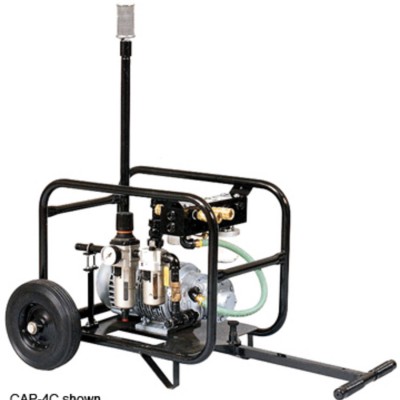CAP-4 Ambient Air Pump
Clemco CAP-4 Ambient Air Pump
The Apollo Ambient Air Pump conveys breathing air from a clean-air environment outside the work area to low-pressure respirators worn by one to four operators inside the blast environment. The CAP-4 pumps air to the respirators without introducing oil, carbon monoxide, or other contaminants.
Requirements for Operation
The following items are required for operation, but are not included with this equipment:
• Compressed air supply between 30 and 70 cfm (depending upon the type and number of respirators used) capable of producing at a minimum of 85 psi with respirators connected, not to exceed 100 psi
• One to four NIOSH-approved low-pressure, type CE supplied-air respirators or up to six full face masks, approved to operate at 10 psi or less, and suitable for the application
• Appropriate approved respirator hose(s)
• Output from the ambient air pump must meet the standard for Grade D breathing air, as defined by the Compressed Gas Association Commodity Specification: G-7.
Description of Operation
The Apollo Ambient Air Pump must be placed outside of the blast environment in an area free of airborne contaminants. These potential contaminants include, but are not limited to the following — fumes from paints and solvents, exhausts from vehicles and compressors, smoke from burn barrels, and dust from abrasive blasting or other construction activities.
The ambient air pump moves air from a clean location to supply low-pressure respirators. To increase its effective range, the ambient air pump can be connected to an optional remote inlet kit — which allows the air inlet to be located up to 300 feet from the pump.
Before blasting begins, and before putting on the respirator, the operator connects the respirator hose to the ambient pump and to the fixed-orifice air inlet at the respirator. The operator starts the compressor, turns on the ambient air pump, adjusts the pressure, and checks for leaks, then puts on the respirator in a clean environment.
After blasting, the operators keep the respirators on and connected until they reach an area free of airborne dust and contamination.
The primary air connection uses a special quick-connect fitting that allows air to flow, even when not connected to a respirator. This keeps hazardous dust or other contaminants from entering the hose at the connection point.
Advantages
• Supplies air for up to four blast operators wearing type CE helmets or up to six operators wearing full face masks
• Eliminates the expense of separate compressor for breathing air
• Uses compressed air for power; works where no electric power is available
• Eliminates danger of carbon monoxide poisoning caused when high temperatures break down compressor’s lubricants
• Requires no temperature alarms or additional air line filters
• Works with Clemco’s CO Monitor Alarm (when specifications call for air monitoring)
• Model CAP-4C includes integral two-wheel cart and extendable handle
• Protective cage (both models) shields critical components from damage
• Easy to operate and maintain
• Can serve as air source for other respirators that operate at 9 cfm at 10 psi
CAP-1 Ambient Air Pump
Clemco CAP-1 Ambient Air Pump
The Apollo Ambient Air Pump conveys breathing air from a clean environment outside the work area to a low-pressure type CE supplied-air respirator worn by an operator inside the blast environment or work zone. The oil-less pump moves the air from a clean-air environment to the respirator without introducing oil, carbon monoxide, or other contaminants.
Requirements for Operation
The following items are required for operation, but are not included with this equipment:
• Electric power supply — 110-115 volt, 60 cycle, 14 amp
• NIOSH-approved low-pressure, type CE supplied-air respirator approved to operate at 10 psi or less, suitable for the application
• Appropriate approved respirator hose
• Output from the ambient air pump must meet the standard for Grade D breathing air, as defined by the Compressed Gas Association, Commodity Specification: G-7.)
Description of Operation
The Apollo Ambient Air Pump must be placed outside of the blast environment in an area free of airborne contaminants. These potential contaminants include, but are not limited to, the following — fumes from paints and solvents, exhausts from vehicles and compressors, smoke from burn barrels, and dust from abrasive blasting or other construction activities.
The ambient air pump moves air from a clean location to the inside of the low-pressure respirator. To increase its effective range, the ambient air pump can be connected to an optional remote inlet kit
— which allows the air inlet to be located up to 300 feet from the pump.
An optional elevated air inlet raises the inlet three feet above the pump. Before blasting begins, and before putting on the respirator, the operator connects the respirator hose to the ambient
pump and to the fixed-orifice air inlet at the respirator. The operator turns on the pump, adjusts the pressure, and checks for leaks, then puts on the respirator in a clean environment.
After blasting, the operator keeps the respirator on and connected until he or she reaches an area free of airborne dust and contamination.
The air connection uses a special quick-connect fitting that allows air to flow, even when not connected to the respirator. This keeps hazardous dust or other contaminants from entering the hose at the connection point.
Advantages
• Eliminates expense of breathing air compressor
• Eliminates danger of carbon monoxide poisoning caused when high temperatures break down a compressor’s lubricants
• Requires no temperature alarms or additional air line filters
• Works with Clemco’s CO Monitor Alarm (when specifications call for air monitoring)
• Hand portable
• Easy to operate and maintain
• Can be used as air source for other respirators that operate at 9 cfm at 10 psi


